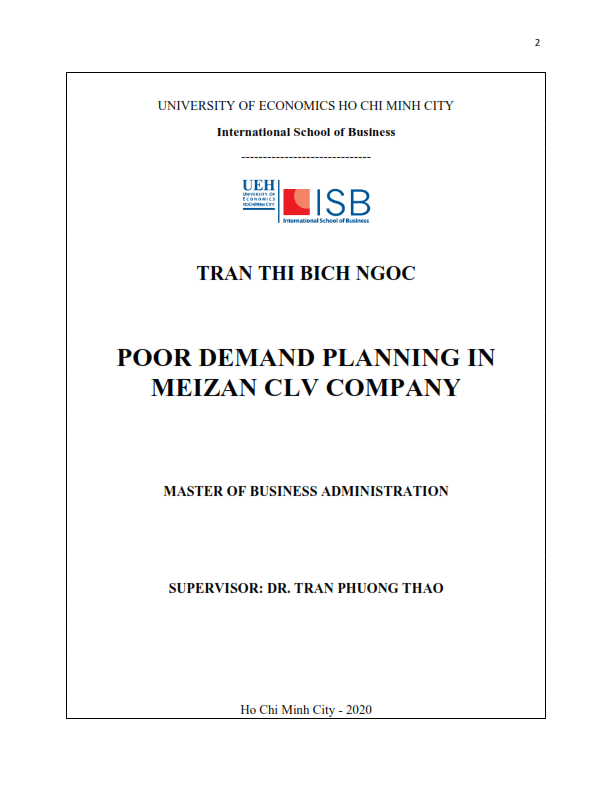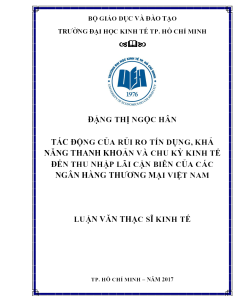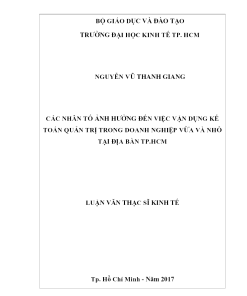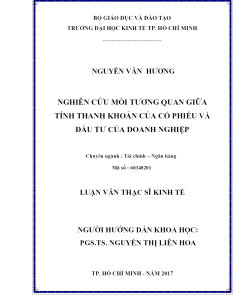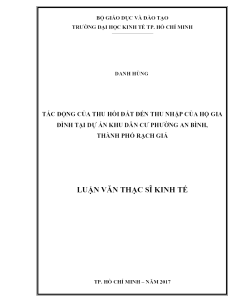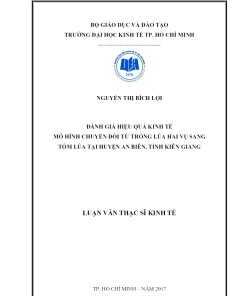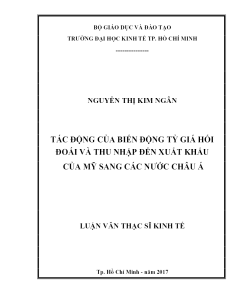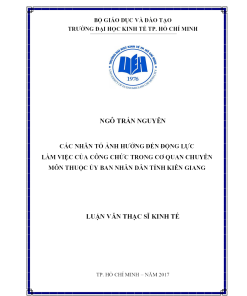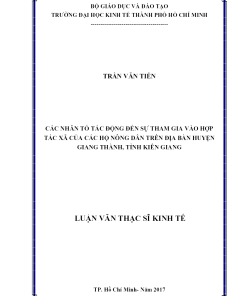- Giảm 10% phí tải tài liệu khi like và share website
- Tặng 1 bộ slide thuyết trình khi tải tài liệu
- Giảm 5% dịch vụ viết thuê luận văn thạc sĩ của Luận Văn A-Z
- Giảm 2% dịch vụ viết thuê luận án tiến sĩ của Luận Văn A-Z
Poor demand planning in Meizan CLV Company
50.000 VNĐ
Download Master Thesis: Poor demand planning in Meizan CLV Company
Download Master Thesis: Poor demand planning in Meizan CLV Company
Demand planning is critical step in Sales and Operation Planning process which ensure operation in manufacturing work smoothly, make balance between supply and demand to avoid wasting from overstocking inventory as well as loose customer satisfaction from shortage of stocks. Bursa (1) said that in order to respond to uncertainty of market, demand planning as the key driver in the process to make high demand forecast accuracy with suitable method chosen such as leverage multiple demand signals (sales and order history, shipments, point of sales, new product launching plans, promotions program, syndicated data, competitors’ information, etc.).
Meizan CLV Company (Meizan CLV) is manufacturing company in food industry being high competitive market with high market volatility and significant impact from competitors. It requires a good demand planning to ensure smooth operation, optimize costs as well as using working capital efficiently to gain competitive advantage.
Meizan CLV has strong sales growth during operation since started in mid-2017; however too high stock level in warehouse will invite some serious issues which affect to smooth of operation as well as long term growth of company. Observing this problem, this study will analyze analyses to find out cause of problems and create solution to solve the exist problem in Meizan CLV.
Keywords: Business logistics, Supply chain managment
EXECUTIVE SUMMARY ………………………………………………………………………………………………………….. 8
1. PROBLEM CONTEXT ………………………………………………………………………………………………………… 9
1.1 Meizan CLV company overview …………………………………………………………………………………….. 9
1.2 Symptoms: …………………………………………………………………………………………………………………. 11
1.2.1 Over warehouse capacity and high stock aging ………………………………………………………… 11
2. PROBLEM IDENTIFICATION…………………………………………………………………………………………… 13
2.1 Problem analysis …………………………………………………………………………………………………………. 13
2.2 Possible problems ……………………………………………………………………………………………………….. 16
2.2.1 Poor demand planning ………………………………………………………………………………………….. 16
2.2.2 Poor purchasing performance ………………………………………………………………………………… 18
2.2.3 Updated map ……………………………………………………………………………………………………….. 20
2.3 Main problem validation………………………………………………………………………………………………. 22
2.4 Problem definition and consequences…………………………………………………………………………….. 23
2.4.1 Problem definition………………………………………………………………………………………………… 23
2.4.2 Consequences………………………………………………………………………………………………………. 24
3. CAUSE VALIDATION………………………………………………………………………………………………………. 25
3.1 Potential causes…………………………………………………………………………………………………………… 25
3.2 Cause Validation…………………………………………………………………………………………………………. 26
3.2.1 Improper forecasting method …………………………………………………………………………………. 26
3.2.2 Inaccurate input information ………………………………………………………………………………….. 28
3.2.3 Misunderstand of internal communication……………………………………………………………….. 29
3.3 Main cause selection ……………………………………………………………………………………………………. 30
4. SUGGESTED SOLUTIONS ……………………………………………………………………………………………….. 32
4.1 Alternative Solutions …………………………………………………………………………………………………… 32
4.1.1 Point-of-sales (POS) data collection ……………………………………………………………………….. 32
4.1.2 Market survey purchasing from data vendors …………………………………………………………… 34
5
4.1.3 Technologies applications……………………………………………………………………………………… 35
4.2 Solution Selection ……………………………………………………………………………………………………….. 36
4.3 Action Plan in the organization……………………………………………………………………………………… 37
5. SUPPORTING INFORMATION …………………………………………………………………………………………. 39
5.1 Summary of Research Method………………………………………………………………………………………. 39
5.2 Summary of Interviews………………………………………………………………………………………………… 41
5.3 A summary of Financial Reports …………………………………………………………………………………… 51
REFERENCES …………………………………………………………………………………………………………………………. 53
6
LISTS OF TABLES
Table 1: Warehouse utilization of Meizan CLV in 2017 – 2019……………………………………………………….. 11
Table 4: Closing stock of finish good of Meizan CLV Company in 2017-2019 …………………………………. 16
Table 5: Monthly demand forecast versus actual sales in 2019………………………………………………………… 17
Table 6: Raw materials stock aging report in Meizan CLV Company in 2019 …………………………………… 19
Table 7: New project spending report in Meizan CLV Company in 2019 …………………………………………. 25
Table 8: Cost arising from over stock holding………………………………………………………………………………..25
Table 10: Interview results with Marketing Director of Meizan CLV ………………………………………………. 30
Table 11: Summary solution options ……………………………………………………………………………………………. 36
Table 12: Action Plan in Meizan CLV Company…………………………………………………………………………… 38
Table 13: Summary of Research Method ……………………………………………………………………………………… 40
7
LISTS OF FIGURES
Figure 1: Organization chart of Meizan CLV …………………………………………………………………………………10
Figure 2: Operation flow chart of Meizan CLV Company ………………………………………………………………. 15
Figure 3: Initial map…………………………………………………………………………………………………………………… 20
Figure 4: Updated map……………………………………………………………………………………………………………….. 22
Figure 5: Two ways feedback in communication of Meizan CLV …………………………………………………….29
Figure 6: Cause and effect map……………………………………………………………………………………………………. 32
8
EXECUTIVE SUMMARY
Demand planning is critical step in Sales and Operation Planning process which ensure operation in manufacturing work smoothly, make balance between supply and demand to avoid wasting from overstocking inventory as well as loose customer satisfaction from shortage of stocks. Bursa (1) said that in order to respond to uncertainty of market, demand planning as the key driver in the process to make high demand forecast accuracy with suitable method chosen such as leverage multiple demand signals (sales and order history, shipments, point of sales, new product launching plans, promotions program, syndicated data, competitors’ information, etc.).
Meizan CLV Company (Meizan CLV) is manufacturing company in food industry being high competitive market with high market volatility and significant impact from competitors. It requires a good demand planning to ensure smooth operation, optimize costs as well as using working capital efficiently to gain competitive advantage. Meizan CLV has strong sales growth during operation since started in mid-2017; however too high stock level in warehouse will invite some serious issues which affect to smooth of operation as well as long term growth of company. Observing this problem, this study will analyze analyses to find out cause of problems and create solution to solve the exist problem in Meizan CLV.
9
1. PROBLEM CONTEXT
1.1 Meizan CLV company overview
In the general trend of the integration process, the lifestyle of Vietnamese people gradually changes in the Western style, fast food chain stores, supermarkets, restaurants, and cakes are increasingly developing. Aiming to meet the increasing demands of consumers for value-added, safe and healthy foods and convenience and in accordance with modern life, Meizan CLV with main business is producing value-added foods from cereals established and put in operation in 2017 has been constantly investing in research and development, product diversification, applying many advanced technologies to production and building, implementing
and maintaining the quality management system and food safety in accordance with FSSC 22000 international standard and ISO 14001 environmental management system, step by step affirming its leading position in the value-added food products processed from cereals in Vietnam and
Laos markets and Cambodia. Currently, Meizan CLV Company uses automation system with closed processing in producing value-added foods from cereals. Especially, in macaroni and egg- noodle segment, only Meizan CLV applies automation system in order to gain cost competitive advantage with small manpower as well as low manpower costs.
Main product segments of Meizan CLV include premix products, macaroni and egg noodle with brand Meizan. Premix segment includes crispy frying premix, seasoned crispy frying premix, Vietnamese pancake, corn starch and tapioca starch with main competitors such
as Tai Ky, Ajinomoto, Vinh Thuan, Huong Xua,..Macaroni and egg noodle competing with main competitors is Safoco being long-standing brand in market. Besides, basing on the available of distribution of Wilmar in Vietnam, it strongly support for Meizan to penetrate grain value added processing industry. After three years operation, Meizan Company reaches at third in the market in which number 1 in crispy premix segment, number 2 macaroni and egg noodle and other segment such as pancake, corn and tapioca starch are still low due to Meizan CLV has just entered this market from 2019.
Mission of Meizan CLV is that to be the Vietnam largest and most innovative player in consumer-pack processed grain food (excluding instant noodle and bakery) in market. Enhance healthy and satisfaction of customers and consumers through constantly improving product quality.
10
Mr. Ho Diep Anh Khoi
General Director
Ms. Tran Thi Bich Ngoc Strategic planning supervisor
Mr. Luu Huynh
Marketing Director
Mr. Le Ngoc Huynh
Marketing manager
Mr. Dao Thai Huy
Chief Accountant
Ms. Duong Hoang Thoai
General accountant
Mr. Co Dinh Huy
Plant Director
Mr. Vu Manh Cuong
Production Manager
Ms. Do Thi Bich
HR manager
Ms. Le Thuy Ai
HR supervisors
Ms. Tu Ngoc Phuong
Procurement
Ms. Nguyen Thuy
Tien
Ms. Nguyen Phuong
Thao
Brand manager
Sales planning for supper market
Ms. Le Ai Nga
Payment accountant
Mr. Nguyen Viet Hung
Workshop Manager
Sales planning for distributors
Ms. Bui Truc Ly
Production accountant
Mr. Nguyen Tang Huy
S.H.E manager
Sales plannig for promotion program
Other accountants
Mr. Le Kha
Logistic manager
Figure 1: Organization chart of Meizan CLV
Meizan Company with general director being responsible for business operation and performance was divided in to seven main departments including:
Marketing department: takes responsibilities of introduction products to customer, finding potential customer, receiving orders, complaints and feedback to customers in market.
Accounting department: is responsible for check the accuracy of bill and document before paying, recording and reporting the cash flow transactions of a company. Besides,
this department has some key roles and responsibilities,
including accounts receivable, accounts payable, payroll, financial reporting, and maintaining financial controls.
Plant: includes four main sub departments such as production is to manufacture products, workshop and maintenance is to repair and maintain production system if have breakdown occurring, S.H.E is to ensure safety and environment of factory, and logistic to storage and distribute goods to customers.
Human resource: it covers but is not limited to human planning, hiring (recruitment and selection), training and development, payroll management, rewards and recognitions, Industrial relations, grievance handling, legal procedures etc…
11
Brand department: do advertising to bring product to be closed to customer by above the line and below the line activities. Besides, brand also design packaging for products, information in packaging legally.
Procurement: is responsible for finding suppliers and purchasing material in order to make sure stable material supply for production and daily activities for company.
Strategic planning department: is responsible for management accounting in company such as evaluates and monitors performance of all departments’ operation as well as business level and report to board of directors.
1.2 Symptoms:
1.2.1 Over warehouse capacity and high stock aging
Inventory of manufacturing firm includes raw materials, work in progress and finished goods. All those are stored in warehouse to manage. Meizan CLV has a warehouse with about
1,000m2, in which 700m2 for finished goods storage and 350m2 for raw materials. According to table 1, warehouse utilization, which is average numbers of stocks every day in warehouse are over capacity of warehouse, is low in 2017 due to Meizan CLV has just ran 6 months, while warehouse utilization in both 2018 and 2019 being about 120% and 105% on average
respectively. Thus, some stocks occupy space of aisles and overload together.
Year 2017 2018 2019
Sales volume (tons) 916 2,290 3,870
Average closing stock (tons) 82 184 423
Warehouse capacity (tons) 154 154 403
Warehouse utilization 53% 120% 105%
Source: Internal report of Meizan CLV Company 2017-2019
Table 1: Warehouse utilization of Meizan CLV in 2017 – 2019
Sales volume has increased significantly from 916 tons in 2017 to 3,810 tons in 2019. Thus, in order to meet requirement of a surge in sales volumes, Meizan CLV was expense capacity from 154 tons in 2017 to 403 tons in 2019 which allows to stock about 2 weeks of sales
12
volumes. However, in fact that, Meizan CLV performed not well as target with longer than 2 weeks stock holding.
According to Mr. Kha, warehouse manager, who shared information on high level of inventory in warehouse
We have expanded warehouse to satisfy stock increasing in 2019. The warehouse
capacity allows us to stock about one week or maximum 2 week of sales according to rule of our group. While stock stays longer than 2 weeks leading to waste space and over warehouse capacity.
All inventories include ingredients, packaging materials and finished goods will store in warehouse to monitor. According to table 2, the movement of stocks in 2017 is about 13-17 days, while it is low, stay over 1 month in warehouse in 2018, and although there is an improvement in 2019, about 10 days for finished goods, 20 days for ingredient materials and up
to 45 days for packaging, it’s still high stock aging causing over capacity of warehouse.
Year Finished product Ingredient materials Packaging
Unit Number of days Number of days Number of days
2017 13 14 17
2018 32 33 61
2019 10 25 45
Source: Internal report of Meizan CLV company 2017-2019
Table 2: Average stock aging of Meizan CLV (days) in 2017-2019
In additional, table 3 shown that inventory turnover of Meizan CLV has an improvement in 2019 about 6 from10; however it’s still too low comparing to industry about 14 in 2018-2019 (2). The slow movement of stock cause high utilization of warehouse.
13
2017 2018 2019
COGS 945,000 3,193,245 5,291,344
Inventory (USD) 361,904 500,783 516,094
Inventory turnover 2.6 6 10
Inventory turnover of
Food industry
18.62 14.1 14.7
Source: Internal report of Meizan CLV company 2017-2019
Table 3: Inventory value and turnover of Meizan CLV in 2017-2019
Brigham and Ehrhardt as cited by Norazira (3) stated that a low turnover is because products tend to deteriorate as staying long in warehouse. It can be interpreted as low sales or high inventories.
2. PROBLEM IDENTIFICATION
2.1 Problem analysis
In Meizan, the linkage between the production department and sales departments is shown in the sales and operational planning process. Particularly, this process helps balance demand and supply, including sales, marketing, demand management, production, inventory management, and new product development and introduction. According to many researchers as cited in Ivert et al. (4), the S&OP process is descripted into five principal activities:
Activity 1: a sales/marketing department is in charge of forecasting demand for coming plan period.
Activity 2: the sales/marketing department build plan for future sales and delivery volumes, and take into consideration of inventory size and the extent of order backlog.
Activity 3: the production department takes responsibility for procurement of relevant materials and prepare production schedule.
Activity 4: managers will gather all relevant people in charge in meeting periodically to review and make any adjustments to the plans in order to achieve plan and meet financial requirement.
14
Activity 5: any unsolved issues will be brought to top management to seek advice and
decision.
below:
Similarly previous study, Meizan CLV also built S&OP process with key points as
Market Demand
Demand Plan
Promotion/POSM
Marketing
Finish good inventory(MCC
WH, Calofic, QN)
Delivery plan to customer from marketing departmen
Materiasl delivery schedule from suppliers
Procurement
Material demand planning
Production/ Procurement
Inventory level
WH/R&D/Production
Production Plan
Production
Production and
warehouse capacity
Production
Maintenance plan
WS
Plan for visitors to factory
ADM
Fumigating plan
QMS
New product trial test
plan
Brand
Production Schedule
Production
15
Figure 2: Operation flow chart of Meizan CLV Company
Demand planning: output of this step is demand forecasting. In this step, marketing department takes responsibilities to connect with related department to collect all related information to do sales demand plan including delivery schedule and demand volumes. Firstly, marketing admin will collect orders from customers to calculate total demand. Secondly, they will check the promotion program of marketing department to measure how much goods company need to give to customers. Then, they will check the balance stock with warehouse to verify how many stocks are available for sales. Finally, from all information of demand, available stocks, marketing admin will work out amount of finished goods requirement for sales and send the request to production department.
Production planning: after receiving sales request from marketing, production admin will connect with all related department collect related information to do production schedule. Checking with production department about capacity of machine and available workers, connect with warehouses to see available raw materials level and send the demand for additional material to procurement to purchase and check other activities can affect production capacity such as plan for visitors to factory, fumigation plans or new product trial test plans. If after take all of conditions into consideration and production can meet sales requests, production admin will create production plan and feedback to marketing department. If not, production admin feedback to marketing to adjust sales plan to be fit with production situation and create production plan.
In terms of the finished goods at the warehouse, Table 4 shows that average stock balance of Meizan CLV, which is average number of stock at the end of each year, is 75 tons in 2017, increased to 176 tons in 2018 and 133 tons in 2019. Balance stock in 2017 was low due to company just started from middle of 2017. Besides, crispy frying premix occupied about 50% of total balance stock, while macaroni still maintained 30% of total balance stock. For egg noodle, company has just built stock and developed from 2019 with 12%.
ThS08.147_Poor demand planning in Meizan CLV Company
| Nơi xuất bản | International School of Business (ISB), Trường Đại học Kinh Tế TpHCM |
|---|---|
| Chuyên Ngành | |
| Loại tài liệu | |
| Năm | |
| Ngôn ngữ |




